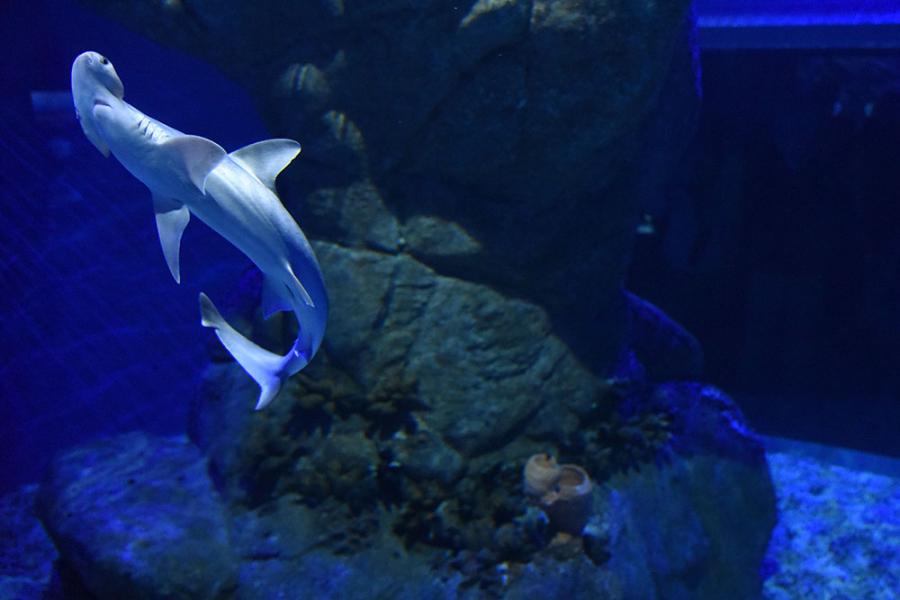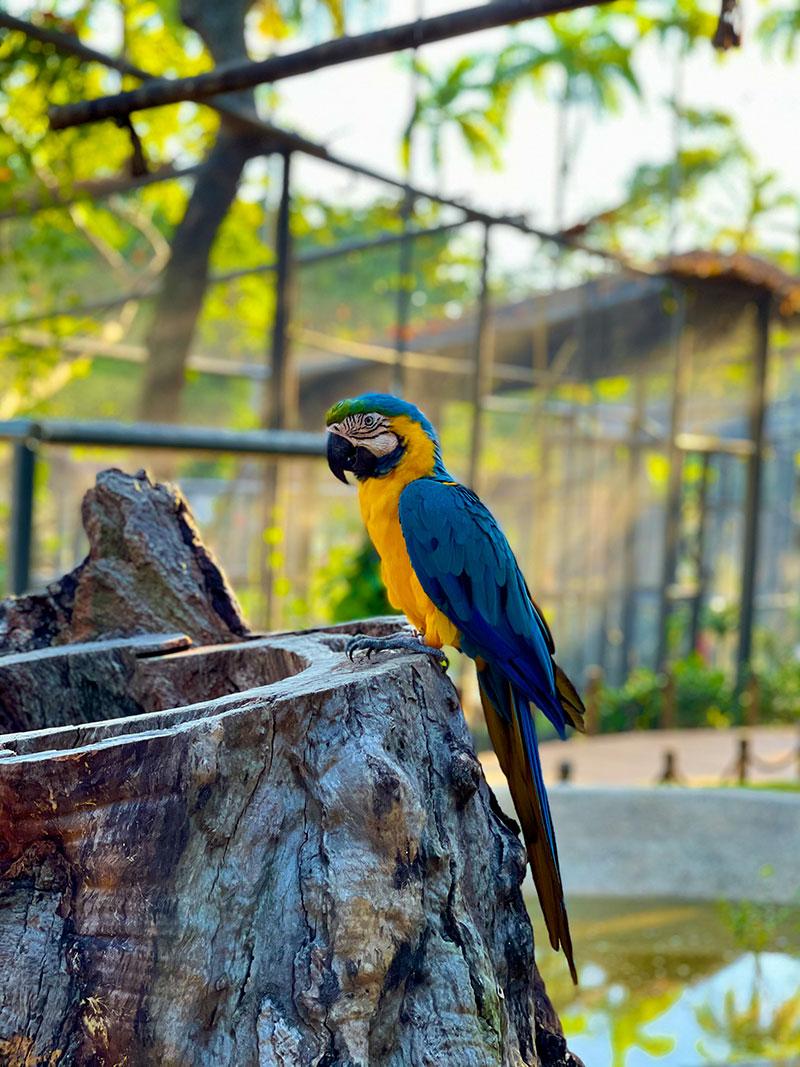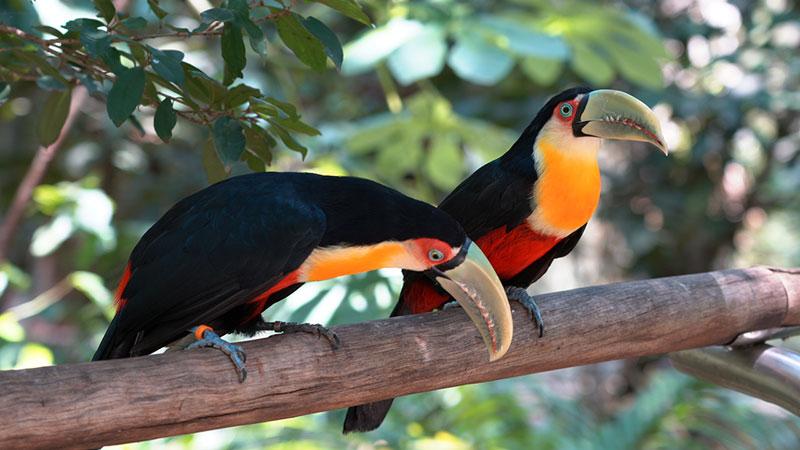Brazilian Zoos and Aquariums are on a Mission
Brazil is home to many zoos and aquariums, including AquaRio, BioParque do Rio, and Parque das Aves found in Rio de Janeiro and Foz do Iguaçu, which borders the breathtaking Iguaçu Falls. Their exhibits allow guests to experience the way animals interact with one another and learn about diverse ecosystems and endangered species. Visitors can enjoy a panoramic view of aquatic life and connect with the Atlantic Forest, discovering the importance of conservation and the protection of animals. These three zoos and aquariums share insights into their missions, professional care of animals, operations, sustainability, and guest experience.

AquaRio
Welcoming guests year-round, Aquário Marinho do Rio de Janeiro, known as AquaRio, sits very close to Rio de Janeiro’s port zone. Spanning approximately 26,000 square meters, it is one of the largest marine aquariums in South America, with habitats including a total of 4.5 million liters of water. The facility encompasses more than 2,000 animals from 350 different species. The largest area is the Recinto Oceânico, with 3.5 million liters of water and 7 meters of depth. Visitors can even cross through an undersea tunnel in this exhibit.
The aquarium’s mission is centered on education, research, and conservation. In just over two years, AquaRio developed 26 studies together with partner institutions, public and private universities, and the Brazilian navy. AquaRio members directly help the aquarium’s research and conservation projects since part of the annual membership program’s proceeds are earmarked for these activities. Additionally, AquaRio carries out, along with the Federal University of Rio de Janeiro, relevant scientific research, having already published several articles in renowned international publications.
“AquaRio is the second most productive aquarium in scientific research in the world, being the only one in the world to achieve complete reproduction of the butterfly ray, one of the most endangered species,” says Marcelo Szpilman, president of AquaRio. With more than 30 years of experience in the environmental field, Szpilman is one of Brazil’s most recognized names in biology. He envisioned the creation of the aquarium for many years. Then, in 2016, the project came to fruition.
The aquarium is also a pioneer in sustainable energy generation; it has installed 6,000 square meters of solar panels on its roof, producing 30% of its demand, and is one of the largest solar projects in Brazil.
While the facility was closed to the public during the COVID-19 lockdown, the management and life support team moved into AquaRio to ensure the animals’ health and well-being by maintaining their regular routines.

BioParque do Rio
Also in Rio de Janeiro, BioParque do Rio operates with the primary purpose of reconnecting the public with nature. The zoo has more than 1,000 animals from 140 species and is located within Quinta da Boa Vista park’s 155,000 square meters.
BioParque—managed by Grupo Cataratas, which also manages AquaRio—was formerly Zoológico do Rio de Janeiro, the oldest zoo in Brazil, with decades of history. Completely renovated, BioParque do Rio’s animals live in habitats surrounded by glass or natural barriers that replicate their environments, encouraging integrated spaces with animals that exist together.
“BioParque do Rio, with only one year of operation, has been actively participating in research projects for the reintroduction of animals, such as [tapirs] (Tapirus terrestris), agoutis (Dasyprocta azarae), and trinca-ferro (Saltator similis); improving veterinary techniques; conditioning; and animal welfare,” says Talita Uzeda, Grupo Cataratas sustainability manager.
Being one of the most accessible zoos in Brazil, the project has guaranteed universal access to people with disabilities. All guests can move through areas such as Reptile Village, Kings of the Jungle, Primate Island, Little Farm, African Savanna, and Tropical Immersion.
Tropical Immersion is a large nursery with over 40 species of wildlife, including the blue-and-yellow macaw. Plus, injured birds are nursed back to health and rehabilitated to fly again.
The institution works on environmental education 100% of the time. The space features a large laboratory that has had several nationwide partners. The BioParque do Rio membership program directly contributes to research and conservation projects for the zoo’s animals, and members have the benefit of visiting as many times as they’d like throughout the year and enjoy exclusive hours and discounts on products at the zoo.

Parque das Aves
Foz do Iguaçu, Brazil, is the site of the famed Iguaçu Falls, the largest waterfall system in the world, with a complex stretch of 275 distinct waterfalls. In this city lies Parque das Aves, which is considered one of the most popular places to visit in Brazil and is recognized for the conservation of exotic birds from the Atlantic Forest.
The park is in an area of more than 16 hectares of forest, strategically located between the Iguaçu River and the road that leads to the falls. The site combines ecotourism and environmental conservation, and huge aviaries include about 1,300 birds from 130 different species from Brazil, Africa, Asia, and Australia. Parque das Aves aims to save native species of the Atlantic Forest and welcomed approximately 800,000 annual visitors for several years before the pandemic.
“We want the tourists to have the best experience possible by creating positive memories of engagement with nature and bring into their life the desire to connect even more with the environment, especially with the Atlantic Forest and its species,” says Rodrigo Chibiaqui, marketing manager for Parque das Aves.
Waste reduction, reusable products, and sustainable materials have become important objectives for the park to offset negative impacts on the environment. This is why the park adopted several eco-friendly measures among visitors and employees, such as obtaining many restaurant ingredients and products from local suppliers and partnering with an ice cream factory in the city to make ice cream and popsicles with ingredients from the Atlantic Forest. The entire production chain, from the fruit producer to the points of sale, is part of this collaboration, which creates flavors like pineapple, tangerine, strawberry, and lemon. Potable water is also offered throughout the facility, drastically minimizing the use of plastic packaging in the park.
During the pandemic, biologists, veterinarians, zoo technicians, and other employees who deal directly with the care of animals continued their face-to-face routine to provide the best possible care. To ensure the safety of professionals and allow the care of the animals to be unaffected, they were separated into fives groups that worked on alternate days, following health protocols established during the pandemic.
These three parks are just a sample of what Brazil has to offer in sharing its rich diversity in wildlife and eco-conservation. A visit to one, or all, of the parks can both educate and amaze guests from around the world.
- Mila Soares is a Brazilian journalist, based in Orlando, covering attractions for publications in Brazil.
